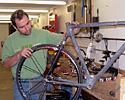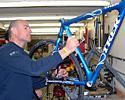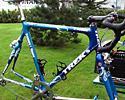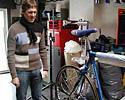
Recently on Cyclingnews.com |
Tech feature - April 13, 2005
Pavé pounding made easier
Inside George Hincapie's Roubaix runner-up Trek SPA proto
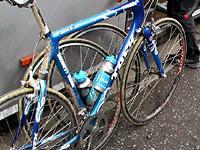
|
When George Hincapie was pounding the pave' in Sunday's Paris-Roubaix, the lanky American had a little help from his bike sponsors Trek to get to the Roubaix velodrome. Sure, it was mostly Hincapie's legs that got him there, but he may have been fresher because his Trek prototype bike was using some new suspension technology from the Wisconsin outfit called SPA (Suspension Performance Advantage). Trek says that the SPA technology reduces road shock and provides increased traction for a more efficient transfer of power, thanks to a lightweight suspension unit built into the seatstays. Originally developed by Gary Klein in 2001, the SPA system is a simple microcellular elastomer spring that is placed in the wishbone seatstay. It provides 13mm (1/2 inch) of travel and doesn't rely on articulating pivots for suspension action.
Last spring after Paris-Roubaix, engineer Doug Cusack from Trek's Advanced Concept Group realized that this lightweight microcellular spring might be adapted to a special bike to conquer the pavé at Paris-Roubaix. The initial Trek OCLV Carbon SPA prototypes were built in the summer of 2004 and sent to Europe where George Hincapie, Max Van Heejswyk and Viatcheslav Ekimov began testing. Initial feedback was very favorable and Trek decided to build a second version of the bike that could actually be raced.
|
|
|
|
|
|
|
|
|
In March, Scott Daubert, Trek team liaison for Trek to the pro peloton carried some SPA protos to Europe by hand. Daubert told Cyclingnews, "I don't think I've ever had to deliver a product as unusual as these bikes we built for the Discovery team's spring classics assault - road frames with rear suspension! Although I never saw this one coming, I 'm not surprised. Trek continues to use Lance and the Discovery team as one of our best methods of real-world product evaluation."
The input from the Discovery riders has been very positive. Stijn Devolder raced the bike in the Three Days of The Panne and finished second on stage one. Roger Hammond also tested the bike on the cobbles and told Daubert, "I rode the prototype bike with the SPA rear suspension. It felt really good. I did a small sector of cobbles, and the bike handled really well and took the edge off the cobbles." Other Discovery riders echoed Hammond's comments in the run-up to Roubaix. Hincapie, who was obviously happy enough with the system in testing to use it in battle, commented, "I don't notice it on the road but it glides on the cobbles." Leif Hoste said, "It's really good. Super fast. I'm happy for sure happy with it."
Ryder Hesjedal, who as a former mountain biker is a bit used top bumpyt surfaces, said, "Nothing can take away the harsh ride of the cobbles but this takes the edge off, for sure." Team sports director Dirk Demol, himself a winner of the Queen of the Classics was positive as well, saying, "The boys, they really like the bike. Now all we need is for the UCI to not stop us!"
There were some questions whether the SPA prototypes would pass the UCI technical inspection before Roubaix, but Discovery team management and the race officials reached an agreement on the bikes and Hincapie rode the Trek SPA prototype to a superb second place podium finish in the 103rd edition of Paris-Roubaix.
Trek SPA tech details
Don't expect to head to your Trek dealer soon for a SPA, these bikes are prototypes. The SPA frames raced in Roubaix began life as a production Trek 5000s; OCLV 120 carbon fiber frames were used because monostay seatstays were the most appropriate for the mechanical characteristics of the installing the shock, which was made from a proprietary custom-tuned Elasto-cel spring compound made for Trek by BASF in Germany which weighs only 80 grams (2.85oz). Trek uses three different durometers for the Klein Reve' bikes, but the Discovery team protos have a stiffer spring made with a seventy weight durometer rating. First, the rear monostay is cut in half above the rear wheel and the shock system is installed, re-glued, and set to go.
The original SPA protos from 2004 used seat stays from the Klein Rêve, but they splayed the rear end out a bit much and didn't provide the needed wheel clearance, so the second round of SPA protos use OCLV Carbon stays from the Trek 2300. To further prepare the Trek SPA proto for the pavé, the Bontrager Carbon Race fork was extended to provide an additional 10mm of wheel clearance for wider 28mm tires.

